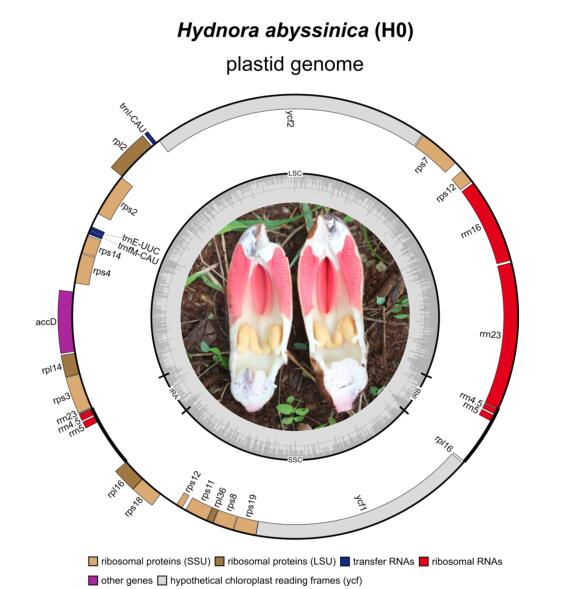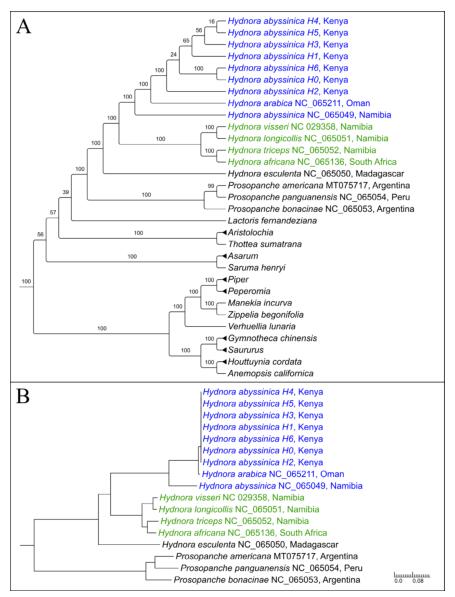Name:HU Guangwan
Tell:
Email:guangwanhu@wbgcas.cn
Organization:Wuhan Botanical Garden
Phylogenetic and Comparative Analyses of Hydnora abyssinica Plastomes Provides Evidence for Hidden Diversity within Hydnoraceae
2023-08-30
Recently, researchers from the East African Flora and Taxonomy Group of Wuhan Botanical Garden, Chinese Academy of Sciences carried out phylogenetic analysis of Hydnora plants of the Hydnoraceae family by means of plastid genome sequencing, assembly and annotation after comprehensive data query and data collation. The study, titled "Phylogenetic and comparative analyses ofHydnora abyssinicaplastomes provide evidence for hidden diversity within Hydnoraceae" was published in the SCI journal BMC Ecology and Evolution.
The family Hydnoraceae consists of the two genera Hydnora and Prosopanche. The former is distributed from Southern Africa to the Arabian Peninsula and Madagascar, the latter from South to Central America. This holoparasitic family of root parasites is among the oldest parasitic angiosperm lineages, and places within the magnoliid order Piperales. Together with Aristolochiaceae, Asaraceae, and Lactoridaceae, they form the perianth-bearing clade within the order. Hydnoraceae are unique among angiosperms due to their extreme loss of morphological features, e.g. the loss of leaves or scales and the ability to release a rotting smell that attracts beetles for pollination, hence described as the "strangest plants on earth”.
According to the Flora of tropical East Africa, three Hydnora species have been recorded in Kenya, namely H. sinandevu Beentje & Q. Luke, H. abyssinica A. Braun, and H. africana Thunb. These species are commonly being used as medicine, as source of food, and their roots are essential for tanning leather. Hydnora abyssinca is described to have the largest distribution range among the members of the family, ranging from Southern Africa to northern East Africa.
Here, researchers explored inter-species plastome diversity in Hydnoraceae for the first time. They reported seven new plastomes of Hydnora abyssinica from Kenya and compared them with published plastomes of H. abyssinica from Namibia as well as to H. arabica Bolin & Musselman from Oman. Based on the genome reconstruction and a resolved phylogenetic hypothesis including a wider sampling in Hydnoraceae, they analyzed their structure, nucleotide composition, as well as codon usage biasness.
The study reports the first plastomes of Kenyan Hydnora abyssinica accessions. The plastomes have a typical quadripartite structure and encode 24 unique genes. Phylogenetic tree reconstruction recovers the Kenyan accessions as monophyletic and together in a clade with the Namibian H. abyssinica accession and the recently published H. arabica from Oman. Hydnora abyssinica as a whole however is recovered as non-monophyletic, with H. arabica nested within. This result is supported by distinct structural plastome synapomorphies as well as pairwise distance estimates that reveal hidden diversity within the Hydnora species in Africa.
This work was supported by grants from the National Natural Science Foundation of China, International Partnership Program of Chinese Academy of Sciences from the Sino-Africa Joint Research Center and Chinese Government Scholarship Program, University of Chinese Academy of Sciences. Kenyan student Elijah Mkala, Matthias Jost from Germany and DONG Xiang from China are the first authors. Professor HU Guangwan is the corresponding author. Several students also participate in the study.

Fig 1. The plastid genome of Kenyan Hydnora abyssinica and its flowers. The accession H0-H6. Genes inside the outer circle are transcribed clockwise,genes on the outside are transcribed counter clockwise. The inner grey circle visualizes the GC content across the plastome (Image by WBG)

Fig 2. Phylogenetic placement of Kenyan Hydnora abyssinica accessions based on the 83 plastid-loci data set as clado- (A) and phylogram (B). Note that H. abyssinica with H. arabica nested within is not recovered monophyletic, with H. arabica. Members of clades II and I (based on jost et al are highlighted in green and blue, respectively (Image by WBG)